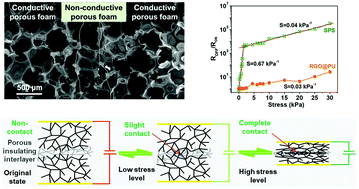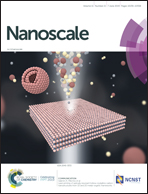Construction of sandwich-like porous structure of graphene-coated foam composites for ultrasensitive and flexible pressure sensors†
Abstract
Ultrasensitive and flexible pressure sensors that can perceive and respond to environmental stimuli have attracted considerable attention due to their potential applications in wearable electronics and electronic skin devices. Here, we report a simple and low-cost strategy to fabricate high-performance pressure sensors via constructing a unique conductive/insulating/conductive sandwich-like porous structure (SPS). Interpenetration of the conductive graphene network throughout the porous insulating interlayer produces a highly efficient transition from the non-conductive to the conductive state. Consequently, the SPS sensors exhibit an extreme resistance-switching behavior (resistance change of >105 at 30 kPa), high sensitivity (∼0.67 kPa−1, <1.5 kPa), fast response/recovery time (∼10 and ∼16 ms) and outstanding mechanical stability. Such SPS pressure sensors are applicable for detecting various mechanical deformation modes (press, bend and torsion) and different stress/strain levels (from gait feature, finger/wrist/elbow movement to breathing monitoring and real-time pulse wave), providing a new concept of device design for wearable electronic applications.



 Please wait while we load your content...
Please wait while we load your content...